Design and 3D Electrical Simulations for a Controllable Equal-Gap Large-Area Silicon Drift Detector
Abstract
1. Introduction
2. Structure Design of the Controllable Equal-Gap L-SDD
3. ThreeDimensional Electrical Simulation of LSDD
3.1. Electrical Potential Distribution of LSDD
3.2. Electric Field Distribution in L-SDD
3.3. Electron Concentration Distribution in L-SDD
3.4. Analysis of the Electrical Performance of Drift Channels
4. Conclusions
Author Contributions
Funding
Data Availability Statement
Conflicts of Interest
References
- Fernando, P.A.I.; Kennedy, A.J.; Pokrzywinski, K.; Jernberg, J.; Thornell, T.; George, G.; Kosgei, G.K.; Wang, Y.; Coyne, K.J. Development of alginate beads for precise environmental release applications: A design of experiment based approach and analysis. J. Environ. Manag. 2024, 351, 119872. [Google Scholar] [CrossRef] [PubMed]
- Zhu, Q.; Sun, G.; Wang, P.; Sui, X.; Liu, C.; Wang, J.; Zhou, J.; Wang, Z. Imaging the space-resolved chemical heterogeneity of degraded graphite anode through scanning transmission X-ray microscope. J. Power Sources 2024, 591, 233882. [Google Scholar] [CrossRef]
- Gholami Hatam, E.; Pelicon, P.; Punzón-Quijorna, E.; Kelemen, M.; Vavpetič, P. Three-dimensional Element-by-element Surface Topography Reconstruction of Compound Samples Using Multisegment Silicon Drift Detectors. Microsc. Microanal. 2023, 29, 1980–1991. [Google Scholar] [CrossRef] [PubMed]
- van der Ent, A.; Brueckner, D.; Spiers, K.M.; Falch, K.V.; Falkenberg, G.; Layet, C.; Liu, W.-S.; Zheng, H.-X.; Le Jean, M.; Blaudez, D. High-energy interference-free K-lines synchrotron X-ray fluorescence microscopy of rare earth elements in hyperaccumulator plants. Metallomics 2023, 15, mfad050. [Google Scholar] [CrossRef] [PubMed]
- Newbury, D.E.; Ritchie, N.W. Quantitative electron-excited X-ray microanalysis of borides, carbides, nitrides, oxides, and fluorides with scanning electron microscopy/silicon drift detector energy-dispersive spectrometry (SEM/SDD-EDS) and NIST DTSA-II. Microsc. Microanal. 2015, 21, 1327–1340. [Google Scholar] [CrossRef] [PubMed]
- Wu, B.; Xia, J.; Zhang, S.; Fu, Q.; Zhang, H.; Xie, X.; Liu, Z. Elemental composition x-ray fluorescence analysis with a TES-based high-resolution x-ray spectrometer. Chin. Phys. B 2023, 32, 097801. [Google Scholar] [CrossRef]
- Chen, J.; Shi, Y.; Han, X.; Zhang, J.; Shi, Y.; Zuo, F.; Mei, Z.; Lv, Z.; Liu, X.; Mo, Y. High resolution soft x-ray spectrometer: Description and performance. In Proceedings of the Fourteenth International Conference on Information Optics and Photonics (CIOP 2023), Xi’an, China, 7–10 August 2023; pp. 1014–1020. [Google Scholar]
- Manzanillas, L.; Ablett, J.; Choukroun, M.; Iguaz, F.; Rueff, J. Development of an X-ray polarimeter at the SOLEIL Synchrotron. arXiv 2023, arXiv:2309.05587. [Google Scholar] [CrossRef]
- Zhao, K.; Xue, M.; Zhang, Y.; Peng, H.; Wen, S.; Zhang, Z.; Lin, Q.; Xu, Z.; Wang, X.; Ran, H. Measuring the thermal neutron fluence of NTD-Ge using the self-monitoring method. Nucl. Instrum. Methods Phys. Res. Sect. A 2023, 1054, 168425. [Google Scholar] [CrossRef]
- Biassoni, M.; Brofferio, C.; Capelli, S.; Cappuzzello, F.; Carminati, M.; Cavallaro, M.; Coraggio, L.; Cremonesi, O.; De Gregorio, G.; Fiorini, C. ASPECT-BET: An sdd-SPECTrometer for BETa decay studies. Proc. J. Phys. Conf. Ser. 2023, 2453, 012020. [Google Scholar] [CrossRef]
- Bulut, S.; Türemen, G.; Yeltepe, E.; Porsuk, D.; Serin, N.; Kaya, Ü. An irradiation system for nuclear and materials research in a medical cyclotron. Nucl. Instrum. Methods Phys. Res. Sect. A 2024, 1058, 168927. [Google Scholar] [CrossRef]
- Di Giacomo, S.; Utica, G.; Carminati, M.; Borghi, G.; Picciotto, A.; Fiorini, C. Assessment of Silicon Drift Detector Timing Performance for Proton Therapy Application. In Proceedings of the 2021 IEEE Nuclear Science Symposium and Medical Imaging Conference (NSS/MIC), Piscataway, NJ, USA, 16–23 October 2021; pp. 1–4. [Google Scholar]
- Metzger, W.; Engdahl, J.; Rossner, W.; Boslau, O.; Kemmer, J. Large-area silicon drift detectors for new applications in nuclear medicine imaging. IEEE Trans. Nucl. Sci. 2004, 51, 1631–1635. [Google Scholar] [CrossRef]
- Deda, G.; Toscano, L.; Borghi, G.; Carminati, M.; Samusenko, A.; Ficorella, F.; Vignali, M.; Zorzi, N.; Fiorini, C. New SDD arrays for the SIDDHARTA-2 experiment. In Proceedings of the 2023 IEEE Nuclear Science Symposium, Medical Imaging Conference and International Symposium on Room-Temperature Semiconductor Detectors (NSS MIC RTSD), Vancouver, BC, Canada, 4–11 November 2023; p. 1. [Google Scholar]
- Salge, T.; Tagle, R.; Hecht, L.; Ferriere, L.; Ball, A.; Kearsley, A.; Smith, C.; Jones, C. Advanced EDS and µXRF analysis of Earth and planetary materials using spectrum imaging, computer-controlled SEM and an annular SDD. Microsc. Microanal. 2014, 20, 1716–1717. [Google Scholar] [CrossRef]
- Cacciatore, F.; Ruiz, V.G.; Taubmann, G.; Muñoz, J.; Hermosín, P.; Sciarra, M.; Saco, M.; Rea, N.; Hernanz, M.; Parent, E. PODIUM: A Pulsar Navigation Unit for Science Missions. arXiv 2023, arXiv:2301.08744. [Google Scholar] [CrossRef]
- Liu, M.; Li, Z.; Deng, Z.; He, L.; Xiong, B.; Li, Y.; Feng, M.; Tang, L.; Cheng, M. 314 mm2 hexagonal double-sided spiral silicon drift detector for soft X-ray detection based on ultra-pure high resistance silicon. Front. Mater. 2021, 8, 700137. [Google Scholar] [CrossRef]
- Rehak, P.; Gatti, E.; Longoni, A.; Sampietro, M.; Holl, P.; Lutz, G.; Kemmer, J.; Prechtel, U.; Ziemann, T. Spiral silicon drift detectors. IEEE Trans. Nucl. Sci. 1989, 36, 203–209. [Google Scholar] [CrossRef]
- Li, Z. Generalization of the modeling and design considerations of concentric and spiral Si drift detectors. Nucl. Instrum. Methods Phys. Res. Sect. A 2013, 730, 73–78. [Google Scholar] [CrossRef]
- Miliucci, M.; Piscicchia, K.; Bazzi, M.; Bragadireanu, M.; Cargnelli, M.; Clozza, A.; De Paolis, L.; Del Grande, R.; Guaraldo, C.; Iliescu, M. Topological charge-sharing background reduction for the Silicon Drift Detectors used by the VIP experiment at LNGS. Appl. Radiat. Isot. 2023, 197, 110822. [Google Scholar] [CrossRef] [PubMed]
- Ono, T. First-principles study of leakage current through a Si/SiO2 interface. Phys. Rev. B 2009, 79, 195326. [Google Scholar] [CrossRef]
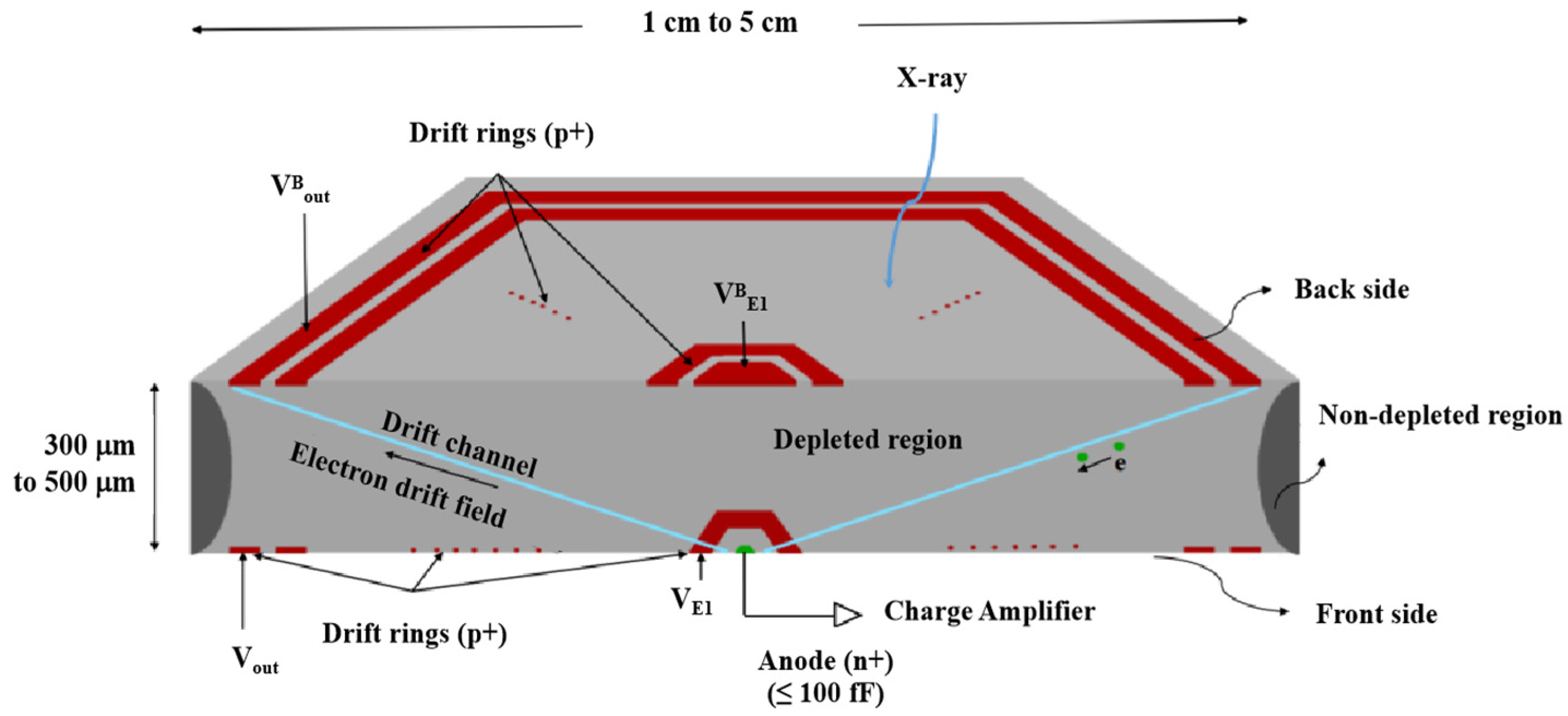
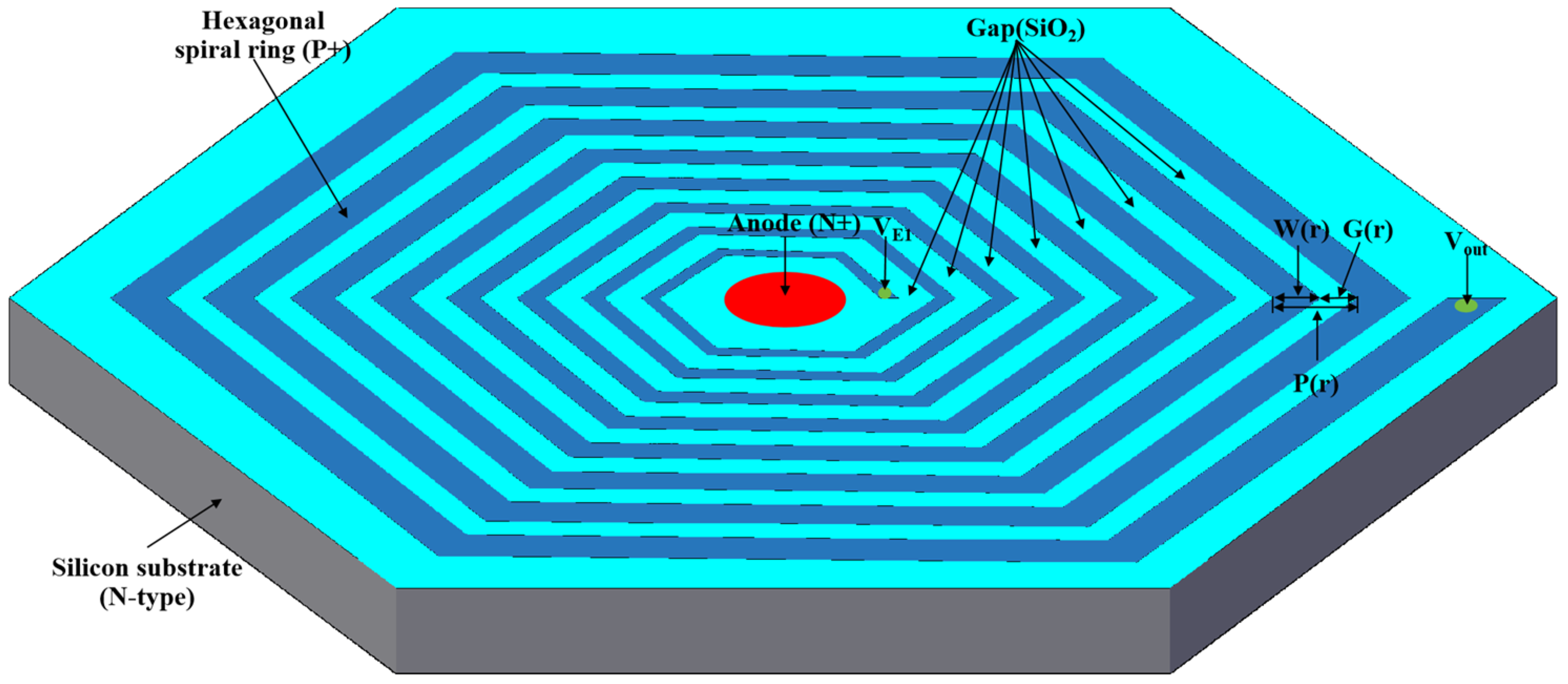

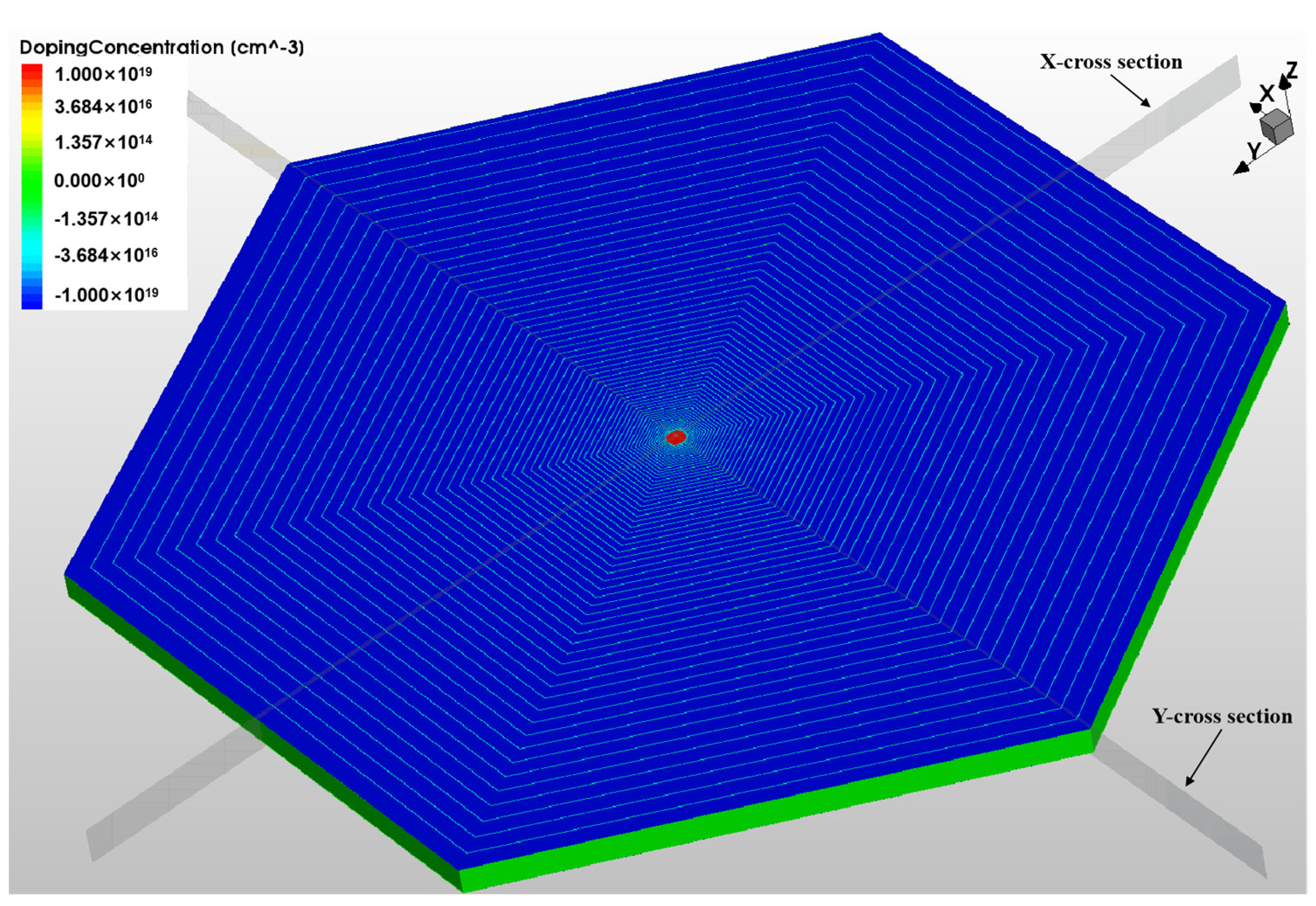



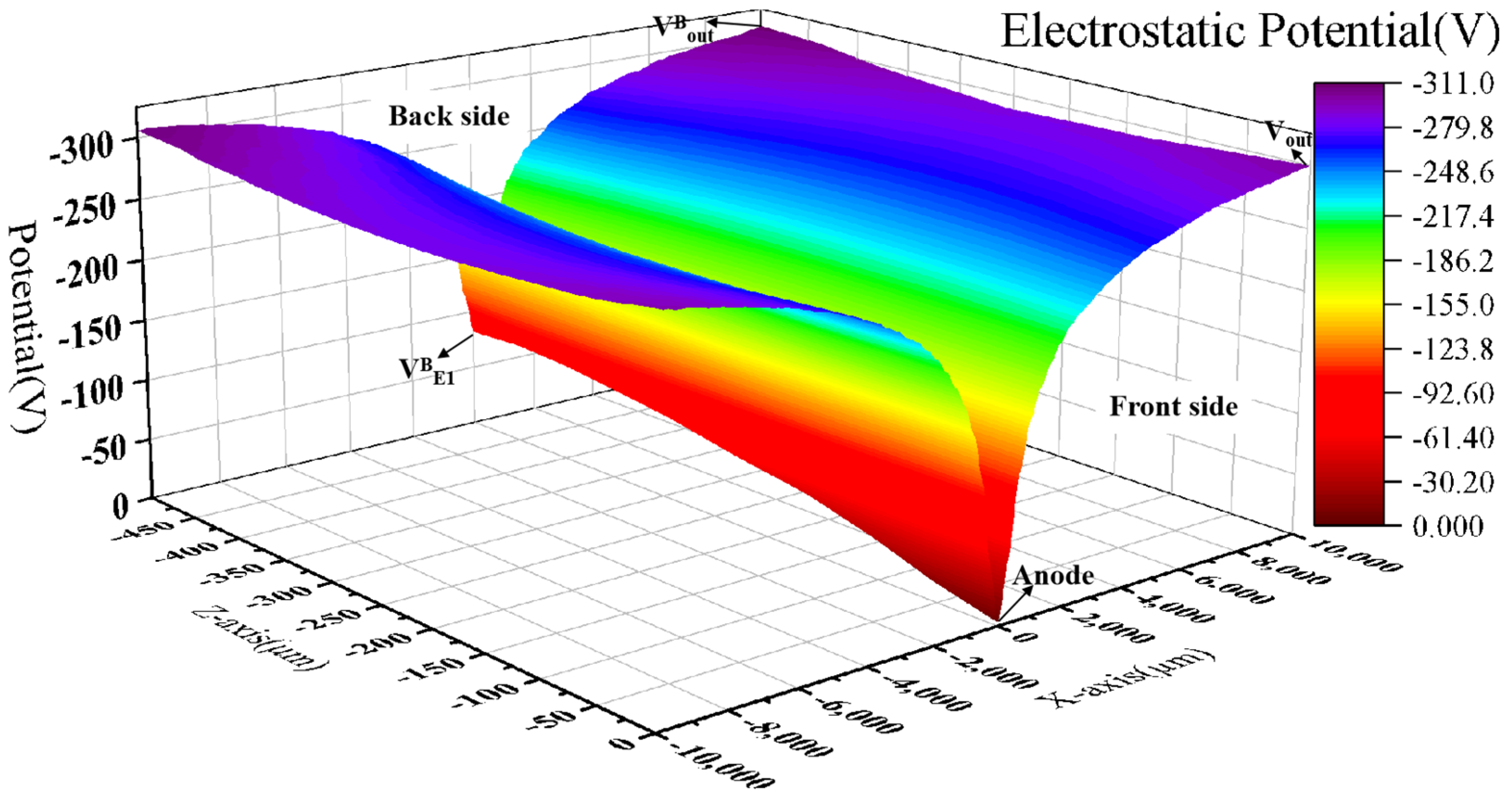
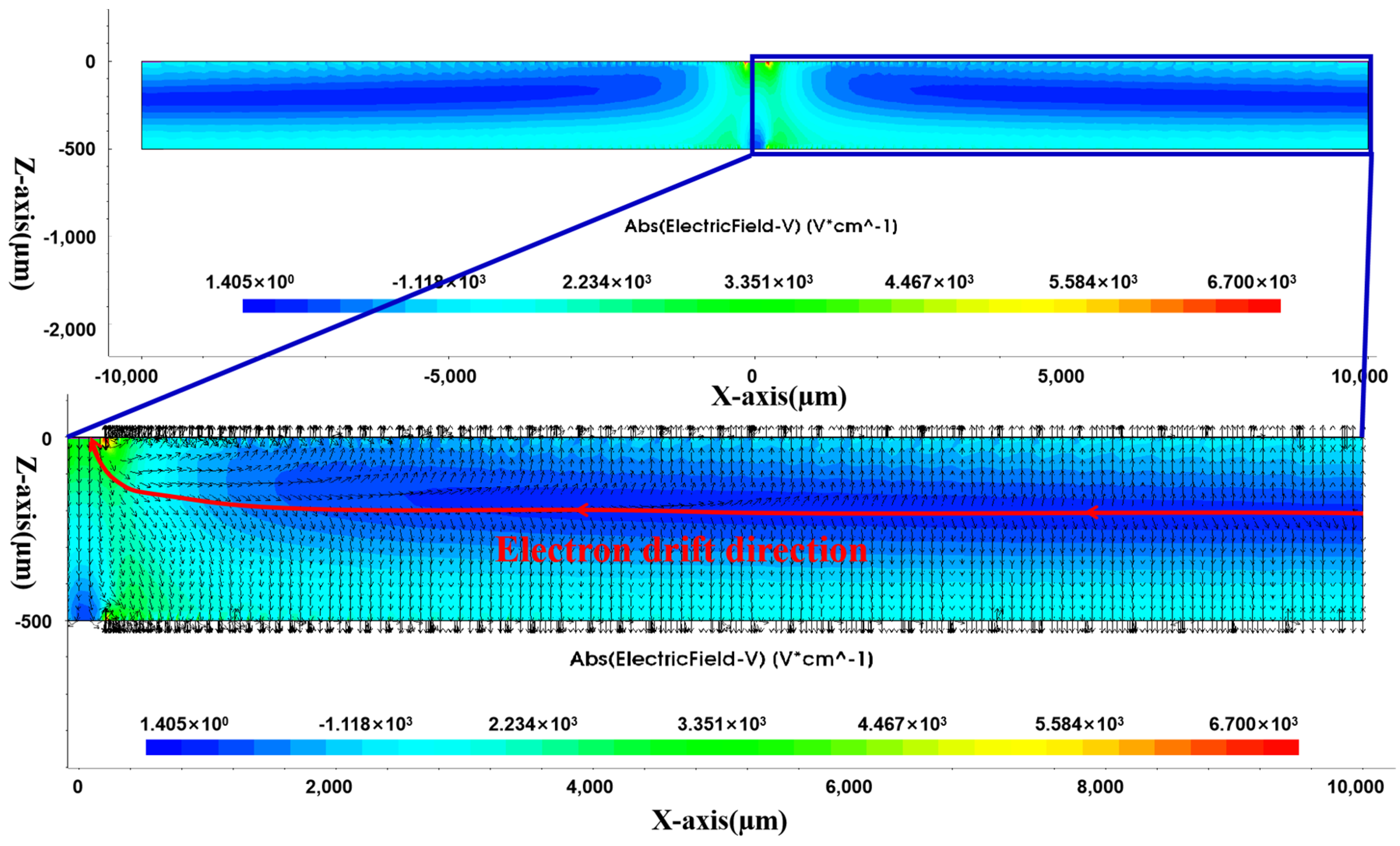
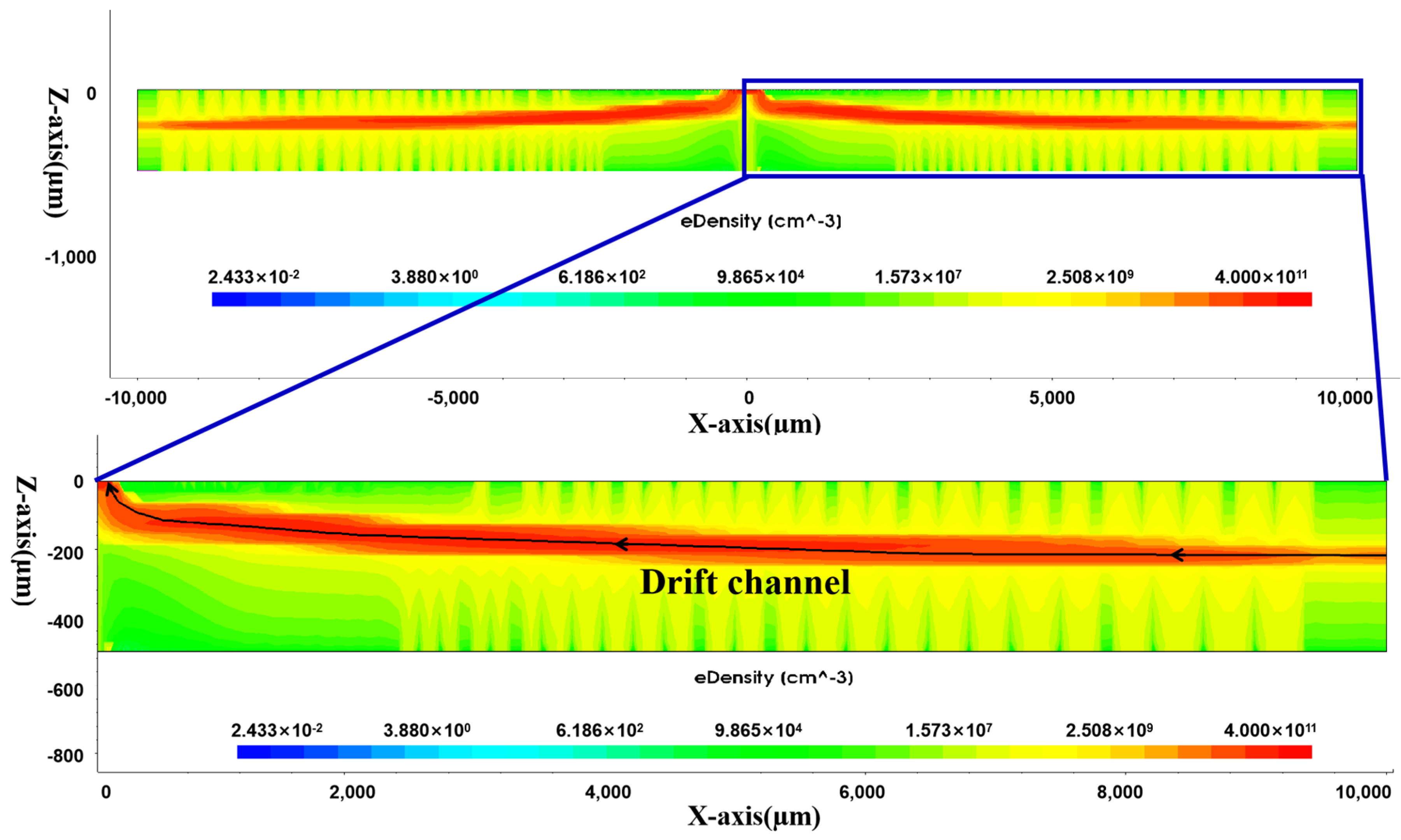
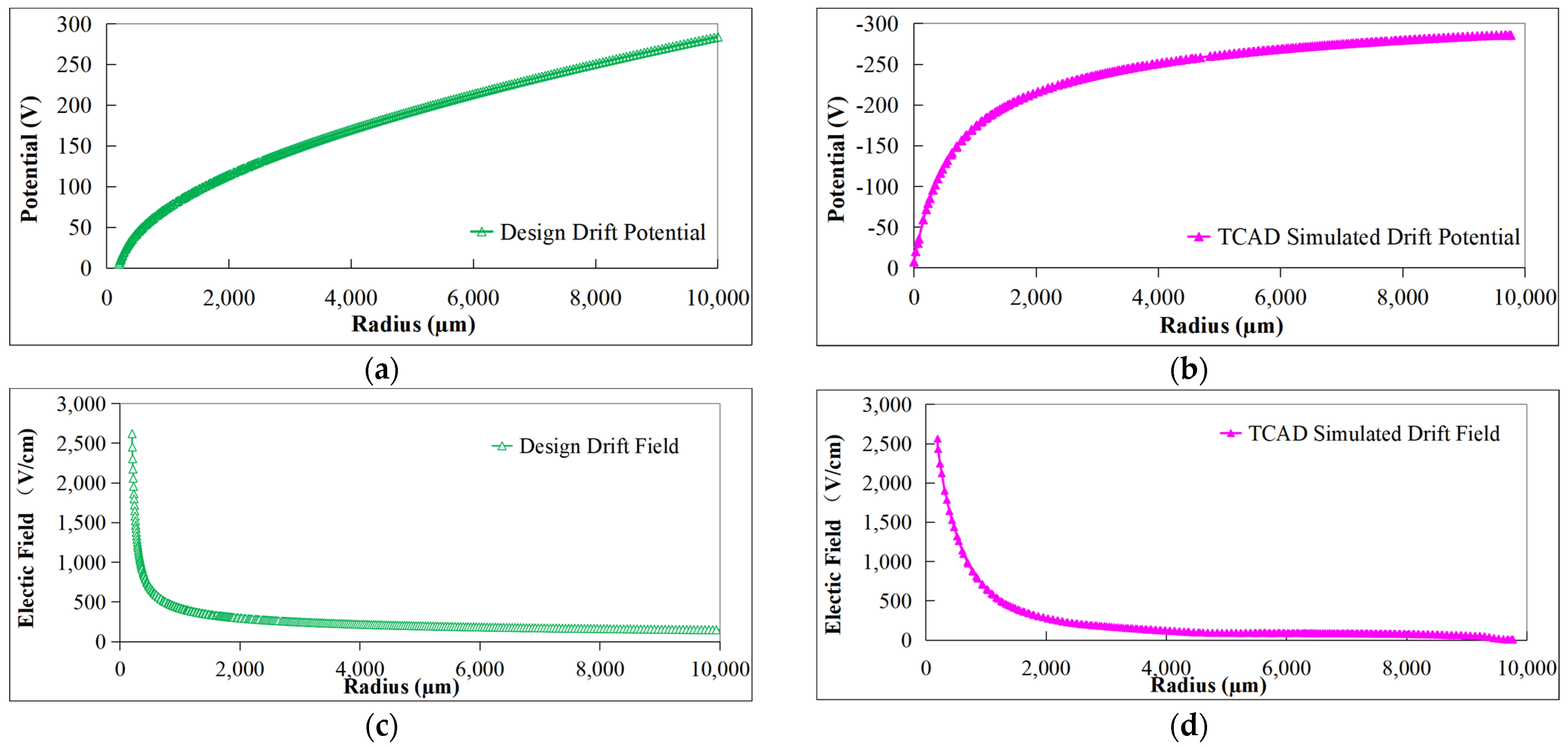



Disclaimer/Publisher’s Note: The statements, opinions and data contained in all publications are solely those of the individual author(s) and contributor(s) and not of MDPI and/or the editor(s). MDPI and/or the editor(s) disclaim responsibility for any injury to people or property resulting from any ideas, methods, instructions or products referred to in the content. |
© 2024 by the authors. Licensee MDPI, Basel, Switzerland. This article is an open access article distributed under the terms and conditions of the Creative Commons Attribution (CC BY) license (https://creativecommons.org/licenses/by/4.0/).
Share and Cite
Zhao, J.; Long, T.; Wang, M.; Liu, M.; Tang, M.; Li, Z. Design and 3D Electrical Simulations for a Controllable Equal-Gap Large-Area Silicon Drift Detector. Sensors 2024, 24, 1388. https://doi.org/10.3390/s24051388
Zhao J, Long T, Wang M, Liu M, Tang M, Li Z. Design and 3D Electrical Simulations for a Controllable Equal-Gap Large-Area Silicon Drift Detector. Sensors. 2024; 24(5):1388. https://doi.org/10.3390/s24051388
Chicago/Turabian StyleZhao, Jun, Tao Long, Mingyang Wang, Manwen Liu, Minghua Tang, and Zheng Li. 2024. "Design and 3D Electrical Simulations for a Controllable Equal-Gap Large-Area Silicon Drift Detector" Sensors 24, no. 5: 1388. https://doi.org/10.3390/s24051388
APA StyleZhao, J., Long, T., Wang, M., Liu, M., Tang, M., & Li, Z. (2024). Design and 3D Electrical Simulations for a Controllable Equal-Gap Large-Area Silicon Drift Detector. Sensors, 24(5), 1388. https://doi.org/10.3390/s24051388





